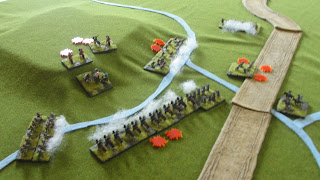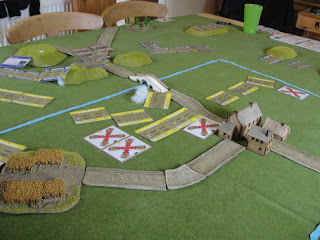After almost a two year absence I managed to drag my Thirty Years War collection out for a scrap somewhere in Europe....
Two 600 point armies - Swedes v Catholic League Germans with their huge Tercios. The streams are passable as rough terrain and all the hills were gentle.
The Swedes won initiative and chose the Eastern table edge opting to play defensively anchored on the two woods with a Cavalry flank to the North and a smaller cavalry command supported by Dragoons and Commanded shot on the Southern flank.
The sausage munchers set up their Tercios in the centre and matched the Swedish deployment with a Cavalry command in the North and a Light Horse, Dragoon and Musket company contesting the broken streams in the south.
Two 600 point armies - Swedes v Catholic League Germans with their huge Tercios. The streams are passable as rough terrain and all the hills were gentle.
The Swedes won initiative and chose the Eastern table edge opting to play defensively anchored on the two woods with a Cavalry flank to the North and a smaller cavalry command supported by Dragoons and Commanded shot on the Southern flank.
The sausage munchers set up their Tercios in the centre and matched the Swedish deployment with a Cavalry command in the North and a Light Horse, Dragoon and Musket company contesting the broken streams in the south.
 |
| View from Southern flank |
 |
| Catholic League Tercios |
 |
| The Swedish Cavalry Command in the North |
 |
| Mercenary allies support the Swedish Centre |
 |
| The Elite Swedish Yellow Brigade advance past the church |
 |
| Swedish artillery opens the battle at extreme range and would prove to be pretty poor throughout the game |
 |
| The Catholic League Southern flank protecting the stream |
 |
| Despite their size, the Swedish artillery fails to hit the tercios |
 |
| The only casualty of the game caused by Swedish Artillery |
 |
| Dragoons from both sides engage in musketry whilst in the centre the Catholic League presses forward to engage the Swedish Infantry Brigades |
 |
| On the Northern flank, German Karbinryttare score lots of hits on the Swedish Hackapells - only to see them all shrugged off! |
 |
| German artillery adds its firepower to the battle developing near the streams |
 |
| The Catholic League Tercios exchange fire with Swedish Brigades |
 |
| The Swedish Southern flank begins to crumble under the weight of German firepower. As the Swedish Dragoons break, the Cossack Light horse also make for the rear. |
 |
| The Swedish southern flank crumbles and in the centre Catholic Tercio and Swedish Brigades mix it up in melee. The Catholic League are hard pressed despite their advantage in numbers |
 |
| The swirling cavalry melee on the Northern flank continues with the Swedish Hackapells routing under the relentless weight of Kurassiere armour |
 |
| In the centre the Elite Yellow Brigade routs a Catholic Tercio |
 |
| With both flanks reeling the Swedes press forward in the centre hoping to break another Tercio which may swing the tide |

























